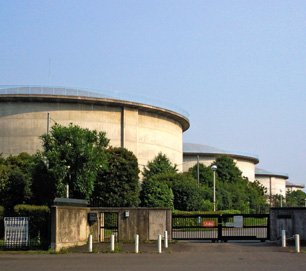Haloacetic Acids (HAA5)
| EPA Maximum Contaminant Level (MCL) |
0.060 mg/L |

A water purification plant in Tokorozawa, Japan.
Haloacetic acids (also known as halogenated acetic acids, HAAs or HAA5) are chemicals that can form as a result of water treatment, when water acidity and temperature are slightly high and treatment chemicals react with organic particles or bromide. They can occur during water treatment involving chlorination, chloramination or ozonation. The EPA regulated “HAA5” include:
- Monochloroacetic Acid (MCA)
- Trichloroacetic Acid (TCA)
- Dichloroacetic Acid (DCA)
- Monobromoacetic Acid (MBA)
- Dibromoacetic Acid (DBA)
Health Effects of Haloacetic Acids (HAA5)
Exposure to large amounts of haloacetic acids has been shown to affect the liver, kidneys, eyes, nervous system and reproductive system. Animal studies have shown that dichloroacetic acid (DCA) and trichloroacetic acid (TCA) are potential carcinogens.
Water Treatment for Haloacetic Acids (HAA5)
According to the EPA, pre-filtering water prior to disinfection treatment can effectively prevent the formation of haloacetic acids:
The most effective way to reduce HAA concentrations is to remove the organic precursor compounds that result in the HAA formation. Organic matter can be reduced by conventional treatment (coagulation, sedimentation and filtration).
Haloacetic acids can also be treated using home treatment methods including activated carbon filtration and reverse osmosis.
Sources: EPA, Government of Saskatchewan, WHO (1), WHO (2), Photo: WikiMedia, author: tokoro koko
Site Index
Filtration Systems
- Aeration for Iron & Sulfide
- Backwashing Filters
(whole house & well units)
- Chlorine & Chemical Injectors
- Countertop Water Filters
- Garden Hose Filters
- Reverse Osmosis, Residential
- Reverse Osmosis, Commercial
- Shower Filters
- Specialty Filters
- Ultraviolet Systems
- Undersink Filters
- Water Softeners
- Whole House Filters
Cartridges
Parts
- Replacement Parts
- Faucets
- Filter Media
- Fittings
- Housings
- O-rings
- Pumps
- Pura UV
- R.O. Parts
- R.O. Tanks
- R.O. Booster Pump
- VIQUA UV